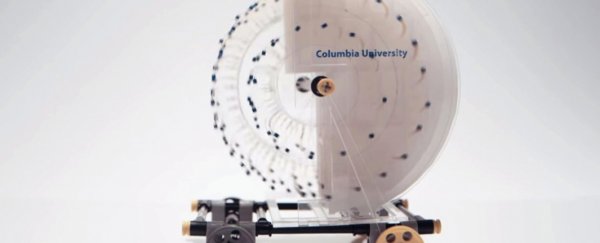Scientists in the US have shown that evaporating water could be an abundant new source of clean, renewable energy, and it's already powerful enough to light up a small LED and power a miniature car.
With around 70 percent of the planet covered in water that's constantly evaporating into the atmosphere, the new technology has huge potential to help us power our homes, transportation and industries, without producing greenhouse gas emissions.
"Evaporation is a fundamental force of nature," lead researcher Ozgur Sahin from Columbia University said in a press release. "It's everywhere, and it's more powerful than other forces like wind and waves." If the technology can be scaled up, his team believes we could one day place giant floating power generators on top of lakes, dams and rivers.
Although scientists have long known that evaporation was a constant and powerful force, they've struggled to find a way to use this energy to generate electricity. But last year, Sahin made a seemingly unrelated discovery - that when common soil bacteria spores shrink and swell as a result of changing humidity, they can push and pull other objects with surprising force.
With this in mind, Sahin and his team stuck Bacillus subtilis spores onto thin strips of tape, similar to cassette tape. This made the tape contract when the air surrounding it was dry, and expand when it was humid. "Several of these strips together can contract with enough force to lift small weights of 0.2 lbs to 0.7 lbs [0.09 to 0.3 kg] – 50 times the weight of the strips themselves," writes Kiona Smith-Strickland for Discover magazine.
 Xi Chen
Xi Chen
The researchers then used these strips - which they're calling hygroscopy driven artificial muscles, or HYDRAs - to build a shuttered structure that floats on water. The humidity produced by the evaporating water causes the tape to expand, opening up the shutters and causing the device to dry out. As the tape shrinks again in the dry air, the shutters are pulled shut, which allows the humidity to build up again, repeating the cycle.
"When we placed water beneath the device, it suddenly came to life, moving on its own," said Xi Chen, a postdoctoral fellow in Sahin's lab. You can see it in action below:
The team used this opening and shutting as a rudimentary piston and linked it to a generator, producing enough electricity to cause a small LED light to flash on and off.
"We turned evaporation from a pool of water into light," said Sahin. Chen speculates, "that an improved version with stickier plastic tape and more spores could potentially generate even more power per unit area than a wind farm".
They also created a 'Moisture Mill' - a plastic wheel covered in the spore-covered tape, which is half covered in a humid environment, and half exposed to a dry environment. This change in moisture causes the tabs to curve and straighten, producing enough force to turn the wheel continuously.
 Joe Turner Lin
Joe Turner Lin
Using the system, the team was able to make a small toy car weighing 0.1 kg roll forwards on its own. Sahin suggests that a larger version of this mill could produce as much electricity as a wind turbine
The research has been published in Nature Communications, and the team is now focussing on scaling up the devices and investigating other ways that the technology can help generate electricity. "Evaporation-driven engines may find applications in powering robotic systems, sensors, devices and machinery that function in the natural environment," they write.
In the meantime they've put a call-out for other researchers to take their idea and run with it. Fingers crossed that further experiments confirm that the technology is as powerful as it seems, because this idea could be an exciting contender in the renewable energy space.
